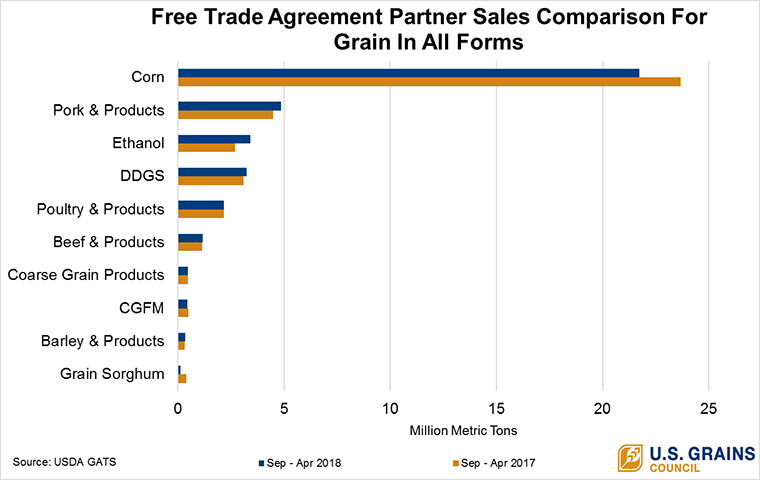After a record-breaking year, exports to the 20 countries with which the United States has free trade agreements (FTAs) have remained steady at 39 million metric tons thus far in 2017/2018 (September 2017-April 2018), according to data from the U.S. Department of Agriculture (USDA) and analysis by the U.S. Grains Council (USGC). These trading partners continue to represent some of the largest and most loyal customers for exports of U.S. corn, barley, sorghum, ethanol, distiller’s dried grains with solubles (DDGS) and other coarse grain products.
The North American Free Trade Agreement (NAFTA) once again ranks as the top FTA for grain-related trade. U.S. exports to Mexico and Canada benefit from geographic proximity and the duty-free access provided by NAFTA. Since its inception in 1994, U.S. agricultural exports to Canada and Mexico tripled and quintupled, respectively.
This growth continues as the Council works to find new areas of demand for U.S. coarse grains and co-products, like ethanol and DDGS, in NAFTA markets. Overall grain in all forms (GIAF) exports to the two countries are up nearly 5 percent year-over-year to 20.3 million tons. Mexico, Canada or both countries currently represent either the first or second largest markets for corn, ethanol, DDGS, barley, beef, pork, poultry and coarse grain products.
Mexico is the largest market for U.S. corn, so far increasing purchases by 8 percent from last year despite ongoing NAFTA talks. Mexico set a new record for U.S. corn purchases in 2016/2017, making Mexico’s increases this year even more notable.
Canada continues to import U.S. ethanol to cover domestic demand, representing the top market among U.S. FTA partners and second largest market for U.S. ethanol overall. Those gallons contribute to U.S. ethanol’s record-setting export streak, increasing 27 percent year-over-year to FTA partners to 381 million gallons. FTA partners South Korea and Colombia also are purchasing substantially more ethanol this marketing year, with increases of 71 percent to 44.9 million gallons and 239 percent to nearly 24.4 million gallons, respectively.
Mexico is responsible for the lion’s share of barley exports to FTA partners, increasing 15 percent to 267,000 tons (12.3 million bushels), thanks to growing demand from Mexico’s large industrial and small craft brewers. Overall, barley exports to FTA partners are up 3 percent year-over-year to 339,000 tons (nearly 15.6 million bushels).
Both Mexico and Canada are using more U.S. DDGS to meet growing demand for feed. Israel and Morocco, also both FTA partners, have realized double-digit growth in exports of DDGS, at 10 and 11 percent respectively. DDGS exports to FTA partners in total are up 5 percent from last year at this time to 3.23 million tons.
Trade disruptions with China continue to rattle the sorghum market, even as the Council and its sorghum partners work to educate world buyers about purchasing opportunities. Overall, sorghum exports to FTA partners are down significantly year-to-date. However, South Korea’s increased purchasing – from 637 tons (25,000 bushels) last year at this time to 58,300 tons (2.29 million bushels) demonstrates the power of staying well-connected and communicative with loyal buyers. The increase in tonnage was a direct result of the Council’s efforts to assist buyers and sellers in rerouting sorghum exports bound for China.
The enduring strength of demand from FTA partners once again emphasizes the importance of the market access provided by these agreements. Working to defend and expand markets allows the Council to do what it does best – capture short-term opportunities and build long-term demand for U.S. coarse grains and co-products.
For more information on the latest trade data, check out the Council’s Feed Grain In All Forms portal here.
About The U.S. Grains Council
The U.S. Grains Council develops export markets for U.S. barley, corn, sorghum and related products including distiller’s dried grains with solubles (DDGS) and ethanol. With full-time presence in 28 locations, the Council operates programs in more than 50 countries and the European Union. The Council believes exports are vital to global economic development and to U.S. agriculture’s profitability. Detailed information about the Council and its programs is online at www.grains.org.

